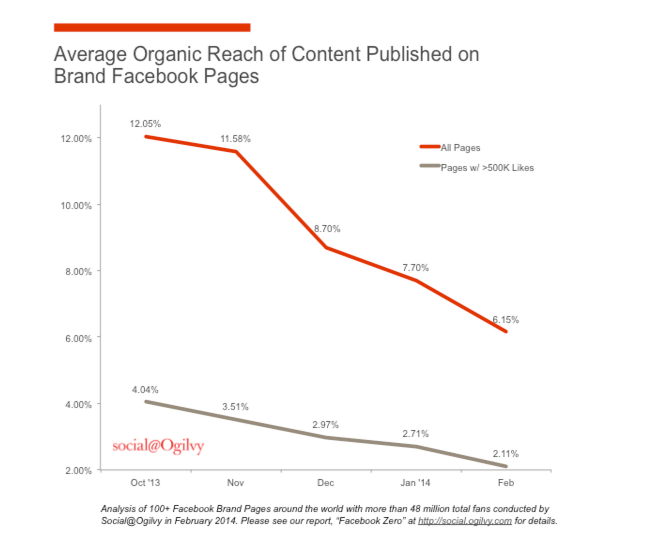Want real results from social? Start paying.
If you think your organic social media posts are delivering diminishing returns, you're not wrong. Columnist Blaise Lucey explains why pay-to-play is becoming the new norm for all social marketing.
Social ROI. What does it mean to you? Besides new followers and fans. Besides clicks and shares. Hard cash. A Facebook fan’s value. The cash money associated with a click on Twitter.
Maybe it means very little.
According to The CMO Survey, 40 percent of CMOs say that social media is underperforming relative to the rest of the organization’s marketing efforts. Just 11.5 percent have said they can prove the impact of social media quantitatively.
Last year, a survey fielded by small business directory Manta showed that 59 percent of small businesses hadn’t seen any ROI from their social media activities. Among those that had seen ROI, 47 percent saw $100 or less in profits.
A lot of people have started talking about this problem. In a podcast from the Content Marketing Institute, Joe Pulizzi and Robert Rose talked about my recent article on the engagement crisis across social channels and content marketing initiatives. They laughed when discussing how people still didn’t understand that to get real results from social, brands have to pay money.
This was my first time hearing that people should take it for granted that social is officially pay-to-play. Think about it: to get results from “social media,” brands have to pay money.
So if you’re wondering what you can do to actually get in front of your social media audience — and connect with new customers — creating entertaining, compelling Facebook content and tweeting more isn’t going to work.
You have to pay.
The story of the reachapocalypse
We all know organic reach on major social networks has declined significantly. There’s some hope that, sure, maybe you can still make a piece of content that goes viral.
But there’s really no such thing as a social feed anymore. When you log onto Facebook or Twitter, you don’t see the most recent content. You see a stream of content served to you by an algorithm. Instagram has recently jumped onto the bandwagon, as well.
We’ve seen how this goes. Users complain (a la #RIPTwitter), they get used to the change, and they keep using the service. One thing is for sure: organic reach will keep going down.
Marketing author Jay Baer calls this “the reachapocalypse.”
If you’re curious why social networks are so passionate about algorithms that, er, optimize a user’s social interactions rather than showing a straight chronological stream, this chart from Jay Baer shows an eerie link to the decline of organic reach on Facebook and Facebook’s stock price.
Solving the social ROI challenge with… money?
The promise of social has always been that with enough great content, you can build up a loyal audience and tap into new customers and prospects. That promise is broken.
Over the past few years, each social channel has transformed into a paid media channel where you have a six- to 12-percent chance of showing content to your existing audience, according to Social@Ogilvy.

Of course, if you’re paying, you have to make sure that social media is integrated with all of your other marketing efforts. The CMO Survey found that on a scale of 1 to 7, CMOs rank average multichannel integration as a 3.4. That’s worse than last year.
To track paid social ROI, you can’t just pay money to broadcast to new audiences. You have to make sure that the promoted content leads back to landing pages and product pages that convert. You have to make sure that the marketing ops team has synced up analytics platforms and databases so you can see which customers are coming from social media.
With a budget for paid promotions — and a concentrated effort to bridge silos — social media ROI really can happen. You can see incredible results. You can get in front of thousands of new people, and you can target demographics in very granular ways.
You just have to pay to do it.
The retro-reach of organic social
Organic social isn’t dead. It’s dormant. Without your wallet, your efforts have a very slim chance of reaching your audience on Facebook, and soon, it seems like the chances will be similarly slim on Twitter and Instagram.
It’s important to remember, though, that even if you don’t pay to have a presence, having a presence can pay. Facebook posts, tweets, Pins and Instagram photos all affect purchasing decisions, even if they don’t directly drive conversions. A recent McKinsey study in Europe shows that 26 percent of purchases, across all categories, are induced by social media.
Whether you’re buying a B2B enterprise product or a backpack, it’s easy to flip through websites and social sites to see which company is selling the best one. These searches often involve channels like Instagram, Facebook, Twitter, Pinterest and others. So, even if they don’t visit your social channels until they’re already thinking about buying your product, social can still affect their perception of the brand and product itself.
If you’re trying to figure out how to turn social media channels into something that drives real revenue, you have to spend money to make money. Then, you have to sync social teams up with the rest of the marketing organization. Otherwise, there’s no real way out of the reachpocalypse, and you’re making great content that only a tiny portion of your audience will ever see.
Opinions expressed in this article are those of the guest author and not necessarily MarTech. Staff authors are listed here.
Related stories
